ACA Digital HT1100 HT1100 Handy Terminal User Manual HT1100 UM EN
ACA Digital Corporation HT1100 Handy Terminal HT1100 UM EN
Contents
- 1. user manual part 1
- 2. user manual part 2
user manual part 1

Handy Terminal HT1100
User Manual

i
Preface
About This Manual
This manual explains how to install, operate and maintain the Handy
Terminal HT1100.
No part of this publication may be reproduced or used in any form, or
by any electrical or mechanical means, without permission in writing
from the manufacturer. This includes electronic or mechanical means,
such as photocopying, recording, or information storage and retrieval
systems. The material in this manual is subject to change without
notice.
© Copyright 2007 ACA-Digital, Ltd. All rights reserved.
Bluetooth is a registered trademark of Bluetooth SIG. Microsoft, Win-
dows and ActiveSync are either registered trademarks or trademarks
of Microsoft Corporation. Other product names mentioned in this man-
ual may be trademarks or registered trademarks of their respective
companies and are hereby acknowledged.

Preface
ii
Regulatory Compliance Statements
FCC Radiation Exposure Statement
This equipment complies with FCC RF radiation exposure limits set forth for an
uncontrolled enviroment. This equipment may be held-in-hand in such way that a
minimum distance of 20 cm between the handheld device and the user's body is
ascertained. The equipment is not approved for body-worn applications.
This device complies with Part 15 of the FCC Rules. Operation is subject to the
following two conditions:
1) This device may not cause harmful interference, and
2) This device must accept any interference received, including interference
that may cause undesired operation.
This transmitter must not be co-located or operating in conjunction with any
other antenna or transmitter.
The equipment with its integral antenna(s) must provide a separation
distance of at least 20 cm from all persons and must not be co-located or
operating in conjunctions with any other antenna or transmitter.
Federal Communications Commission Notice
This equipment has been tested and found to comply with the limits for
a Class B digital device, pursuant to Part 15 of the FCC Rules. These
limits are designed to provide reasonable protection against harmful
interference in a residential installation.
This equipment generates, uses, and can radiate radio frequency
energy. if not installed and used in accordance with the instructions, may
cause harmful interference to radio communications. However, there is no
guarantee that interference will not occur in a particular installation.
If this equipment does cause harmful interference to radio or television reception,
which can be determined by turning the equipment off and on, the user encouraged
to try and correct the interference by one or more of the following measures:
• Reorient or relocate the receiving antenna.
• Increase the distance between the equipment and the
receiver.
• Connect the equipment to an outlet on a circuit different from
that to which the receiver is connected.
• Consult the dealer or an experienced radio/TV technician for
help.
To assure continued compliance, any changes or modifications not expressly
approved by the party responsible for compliance could void the user's authority to
operate this equipment.

Preface
iii
Canada-Industry Canada (IC)
The wireless radio of this device complies with RSS 139 & RSS 210
Industry Canada. This Class B digital apparatus complies with Cana-
dian ICES-003.
Cet appareil numérique de la classe B conforme á la norme NMB-003
du Canada.
Europe-European Union Notice
Radio products with the CE alert marking comply with the R&TTE
Directive (1999/5/EC) issued by the Commission of the European
Community. Compliance with this directive implies conformity to the
following European Norms (in brackets are the equivalent international
standards).
• EN 60950-1 (IEC60950-1) - Product Safety
• EN 300 328 Technical requirement for radio equipment
• ETS 301 489 General EMC requirements for radio equipment.
Products that contain the radio transmitter are labeled with CE alert
marking and may also carry the CE logo.
cUL/UL, TUV, CB, Notice
CCC Notice
On Class A systems, the following warning will appear near the regula-
tory label:
WARNING!This is a Class A product. In a domestic environ-
ment this product may cause radio interference, in which case
the user may be required to take adequate measures.

Preface
iv
Safety
Use the following safety guidelines to help protect yourself and the
HT1100.
CAUTION! Do not operate the HT1100 for an extended period
of time with the base resting directly on your body. With
extended operation, heat can potentially build up in the base.
Allowing sustained contact with the skin could cause discom-
fort or, eventually, a burn.
• Do not attempt to service the HT1100 yourself. Always follow
installation instructions closely.
• Be sure that nothing rests on the AC adapter's power cable
and that the cable is not located where it can be tripped over or
stepped on.
• Place the AC adapter in a ventilated area, such as a desktop
or on the floor, when you use it to run the HT1100 or to charge
the battery. Do not cover the AC adapter with papers or other
items that will reduce cooling; also, do not use the AC adapter
while it is inside a carrying case.
• Use only the AC adapter, power cord, and batteries that are
approved for use with this HT1100. Use of another type of bat-
tery or AC adapter may cause risk of fire or explosion.
• Before you connect the HT1100 to a power source, ensure
that the voltage rating of the AC adapter matches that of the
available power source.
– 115 V/60 Hz in most of North and South America and some
Far Eastern countries such as South Korea and Taiwan.
– 100 V/50 Hz in eastern Japan and 100 V/60Hz in western
Japan.
– 230 V/50 Hz in most of Europe, the Middle East, and the Far
East.
• If you use an extension cable with the AC adapter, ensure that
the total ampere rating of the products plugged in to the exten-
sion cable does not exceed the ampere rating of the extension
cable.
• To remove power from the HT1100, turn it off, remove the bat-
tery, and disconnect the AC adapter from the electrical outlet.
• To help avoid the potential hazard of electric shock, do not
connect or disconnect any cables or perform maintenance or
reconfiguration of this product during an electrical storm.

Preface
v
• When traveling, do not check the HT1100 as baggage. You
can put the HT1100 through an X-ray security machine, but
never put the HT1100 through a metal detector. Be sure to
have a charged battery available, in case you are asked to turn
on the HT1100.
• When traveling, do not place the HT1100 in overhead storage
compartments where it could slide around. Do not drop the
HT1100 or subject it to other mechanical shocks.
• Protect the HT1100 and battery from environmental hazards
such as dirt, dust, food, liquids, temperature extremes, and
overexposure to sunlight.
• When you move the HT1100 between environments with very
different temperature and/or humidity ranges, condensation
may form on or within the HT1100. To avoid damaging the
HT1100, allow sufficient time for the moisture to evaporate
before using the HT1100. Allow the HT1100 to acclimatize to
the room temperature before turning on the power.
• When you disconnect a cable, pull on its connector or on its
strain relief loop, not on the cable itself. As you pull out the
connector, keep it evenly aligned to avoid bending any con-
nector pins. Also, before you connect a cable make sure both
connectors are correctly oriented and aligned.
• Before you clean the HT1100, turn it off, unplug it from its
power source, and remove the battery.
• Do not use this product near water, for example, near a bath-
tub, washing bowl, kitchen sink or laundry tub, in a wet base-
ment or near a swimming pool.
Battery Safety
• Do not place the battery incorrectly as this may cause danger
of explosion.
• Dispose of used batteries according to the manufacturer's
instructions.
• Do not dispose of batteries in a fire. They may explode. Check
with local authorities for disposal instructions.

Preface
vi
Notices
This unit is equipped with a battery pack and backup battery. It is pos-
sible that the HT1100 may not power-on due to battery discharge as a
result of storage.
In the above situation, insert the HT1100 into the cradle and connect
the AC adapter to the cradle. Recharge the unit for 90 minutes in order
to fully charge its backup battery.
The backup battery will recharge from external power when the AC
adapter is connected.
Battery charge notice
It is important to consider the environment temperature whenever you
are charging the Lithium-Ion battery pack. The process is most efficient
at normal room temperature or slightly cooler. It is essential that you
charge batteries within the stated range of 0°C to 50°C. Charging bat-
teries outside of the specified range could damage the batteries and
shorten their charging life cycle.
Storage and safety notice
Although charged Lithium-Ion batteries may be left unused for several
months, their capacity may be depleted due to build up of internal
resistance. If this happens they will require recharging prior to use.
Lithium-Ion batteries may be stored at temperatures between-20°C to
60°C, however they may be depleted more rapidly at the high end of
this range. It is recommended to store batteries within normal room
temperature ranges.

vii
Table of Contents
Preface
About This Manual .............................................................................i
Regulatory Compliance Statements ............................................ ii
FCC Statement.................................................................. ii
Federal Communications Commission Notice.................... ii
Canada-Industry Canada (IC) ........................................... iii
Europe-European Union Notice......................................... iii
cUL/UL, TUV, CB, Notice .................................................. iii
CCC Notice........................................................................ iii
Safety ................................................................................................... iv
Battery Safety .................................................................... v
Notices ................................................................................................ vi
Battery charge notice........................................................ vi
Storage and safety notice................................................. vi
Chapter 1
Introducing the HT1100
Features ...............................................................................................2
Package Contents .............................................................................3
Optional Accessories......................................................... 3
A Tour of the HT1100 .......................................................................4
Front View ......................................................................... 4
Right and Left View ........................................................... 6
Top and Bottom View ........................................................ 8
Back View.......................................................................... 9
Cradle .............................................................................. 10
Chapter 2
Getting Started
Installing the Battery ........................................................ 12
Charging the Battery........................................................ 14
Charging the Battery with the Docking Station ................. 14
Connecting the HT1100 to a PC...................................... 16
Turning the HT1100 on for the First Time ....................... 17
Powering On ............................................................ 17
Calibrating the HT1100 Screen .................................... 18

Table of Contents
viii
Setting the Time and Date ............................................................20
Adjusting the Screen Brightness ................................................21
Chapter 3
Using the Hardware
Keypads and Function Buttons ..................................................23
Entering Alphanumeric Characters ............................................26
Entering Characters with the Keypad .............................. 26
Entering Characters with the Keypad .............................. 27
Using the Stylus ..............................................................................28
Adjusting the Double-Tap Rate ....................................... 29
Inserting a PCMCIA Card ..............................................................30
Removing a PCMCIA Card.............................................. 32
Inserting an SD Memory Card ......................................................33
Removing a Storage Card ............................................... 34
Connecting Devices to the HT1100 ............................................35
Opening the Port Covers ................................................. 35
Connecting USB .............................................................. 35
Connecting a USB Type A .......................................... 35
Connecting a USB Type B .......................................... 36
Connecting a Serial Cable............................................... 36
Connecting Headphones and a Microphone ................... 37
Connecting to the Cradle................................................. 37
Connecting USB ....................................................... 37
Connecting LAN........................................................ 38
Connecting a Serial Cable........................................... 38
Using the Barcode Scanner .........................................................39
Activating the Barcode Scanner ...................................... 39
Launching the Barcode Reading Program ...................... 40
Location and Reading Position........................................ 41
Tilt ......................................................................... 41
Skew ...................................................................... 41
Pitch....................................................................... 41
Reading distances ........................................................... 42
Typical reading distances............................................ 42
Minimum reading distances ......................................... 43
Chapter 4
Getting Connected
Connecting to a PC .........................................................................44

Table of Contents
ix
Installing Microsoft ActiveSync ........................................ 44
Connecting the Device to Your Computer ....................... 47
Synchronizing with Your Computer ...........................................48
Connection Options ......................................................... 48
USB Connection ....................................................... 48
Infrared Connection ................................................... 49
Bluetooth Connection................................................. 50
WiFi Connection ....................................................... 51
Synchronizing Information ...........................................................52
Synchronization Options.................................................. 52
Using ActiveSync to Exchange Files .........................................53
Chapter 5
Scanner Setup
Symbologies .................................................................... 54
Interface........................................................................... 54
Basic Setup ..................................................................... 55
Chapter 6
Advance Settings
Checking the Battery Status ........................................................60
Checking the Battery Status ........................................ 60
Extending Battery Life ...................................................................61
Changing the Automatic Power Settings ......................... 61
Adjusting Backlight Setting .............................................. 62
Performing a Reset .........................................................................63
Performing a Warm Boot ................................................. 63
System Specifications

Table of Contents
x

Chapter 1 — Introducing the HT1100
2
Features
Powerful system
• Microsoft Windows CE 5.0
operating system
• Intel Bulverde PXA270
processor with speed up to
624 MHz
System memory
• 128MB SDRAM on board
• 128 MB Flash ROM
Display
• 3.5-inch transflective QVGA
LCD with touchscreen
• 240 x 320 resolution
Barcode scanner
• Built-in Bar Code Scan
Engine
Communication
• USB Host & Client
• 802.11b/g
• Bluetooth version 1.2
• GPS (optional)
• GPRS (optional)
• RFID (optional)
Audio
• Built-in microphone
• Built-in speaker (optional)
• External microphone
connector
• External headset connector
Expansion slot
•SD
• PCMCIA
Battery life
• Normal usage: 4 hours
continuous use
• Charging time: 90 minutes
User-friendly interface
• User configurable function
keys
• Trigger keys for barcode
scanning
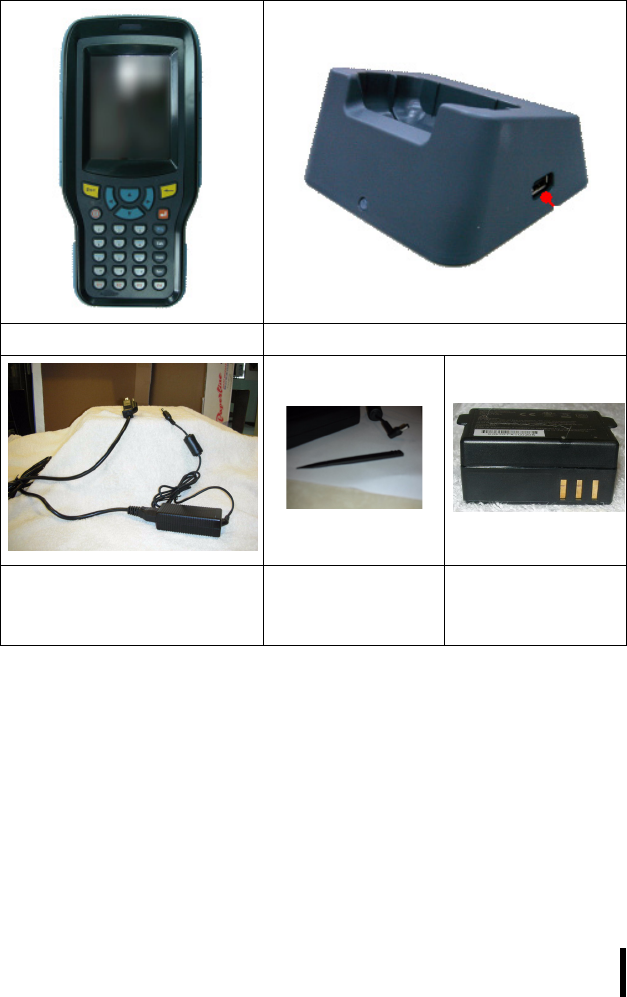
Chapter 1 — Introducing the HT1100
3
Package Contents
After opening the box, ensure the following accessories for the HT1100
are present:
Optional Accessories
The following optional accessories can be used to add to the function-
ality of the HT1100.
• Sleeve with hand strap & shoulder strap
• Vehicle cradle
If anything is missing or appear damaged in any way, contact your
dealer.
HT1100 Terminal Cradle
AC adapter and power
cord
Stylus Rechargeable
Li-ion Smart
battery
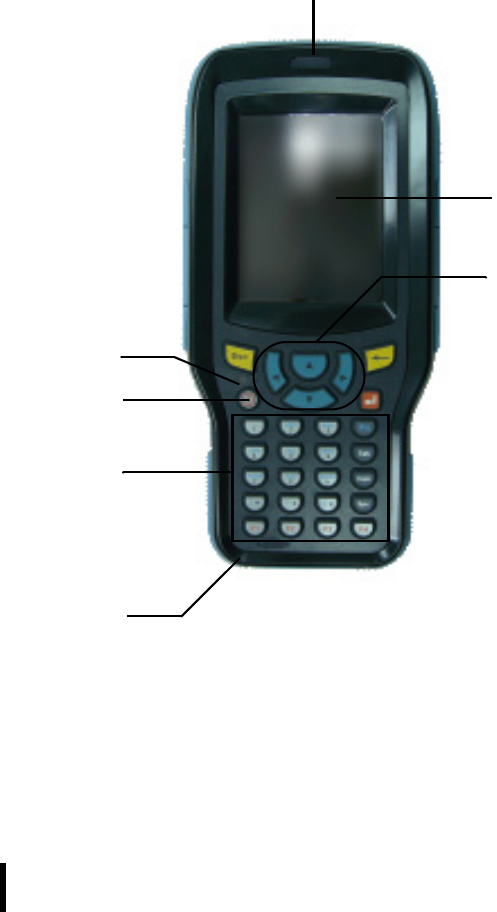
Chapter 1 — Introducing the HT1100
4
A Tour of the HT1100
The following sections describe the main components and features of
the HT1100.
Front View
LCD with
touchscreen
Power
button
Navigation
keys
Function and
numeric key
Power LED
Internal
microphone
(optional)
Scanner trigger LED

Chapter 1 — Introducing the HT1100
5
Component Description
Power LED Indicates the battery charging power
status.
Green - Battery is fully charged or the
device is running on battery power.
When LED flashes, the battery charge
is at 13%. Recharge the battery
immediately.
Red - Battery is charging.
Power button • If the device is off, press this button to
turn it on.
• When the unit is on, press this button
for 1 second to enter power saving
mode. Press the button again to turn
the HT1100 off.
Function and numeric
key
Keypad interface for controlling the
HT1100. See Keypads and Function
Buttons on page 23. for more information.
Internal microphone
(optional)
Enables you to record voice audio.
Navigation Keys Press these keys to navigate in the
HT1100 interface.
LCD touch screen Displays the applications and data stored
on your device. It is touch-sensitive and
responds to the stylus or finger.
Scanner trigger LED Lights when the scan buttons are pressed.
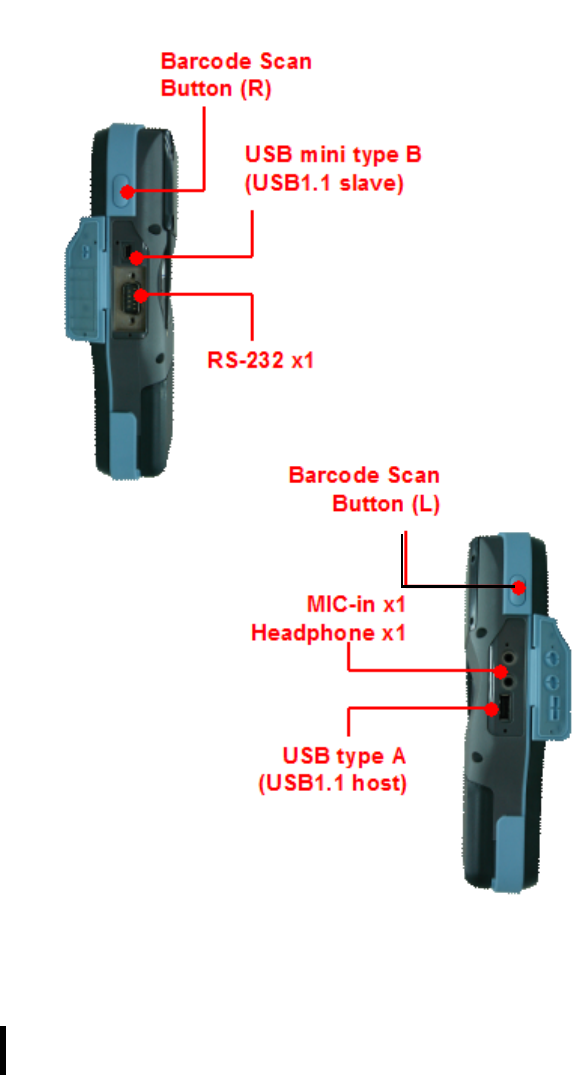
Chapter 1 — Introducing the HT1100
6
Right and Left View

Chapter 1 — Introducing the HT1100
7
Component Description
Right barcode scan
button
Press to activate the barcode scanner.
USB mini type B port
(client)
Connect a USB mini type B connector to
this port.
RS232 port Connect a serial connector to this port for
serial communications.
Left barcode scan
button
Press to activate the barcode scanner.
Microphone jack Enables you to record voice audio with an
external microphone.
Earphone jack Connects to audio line-out devices
(earphones or headphones) for use in
noisy environments.
USB type A port (host) Connect a USB type A connector to this
port.
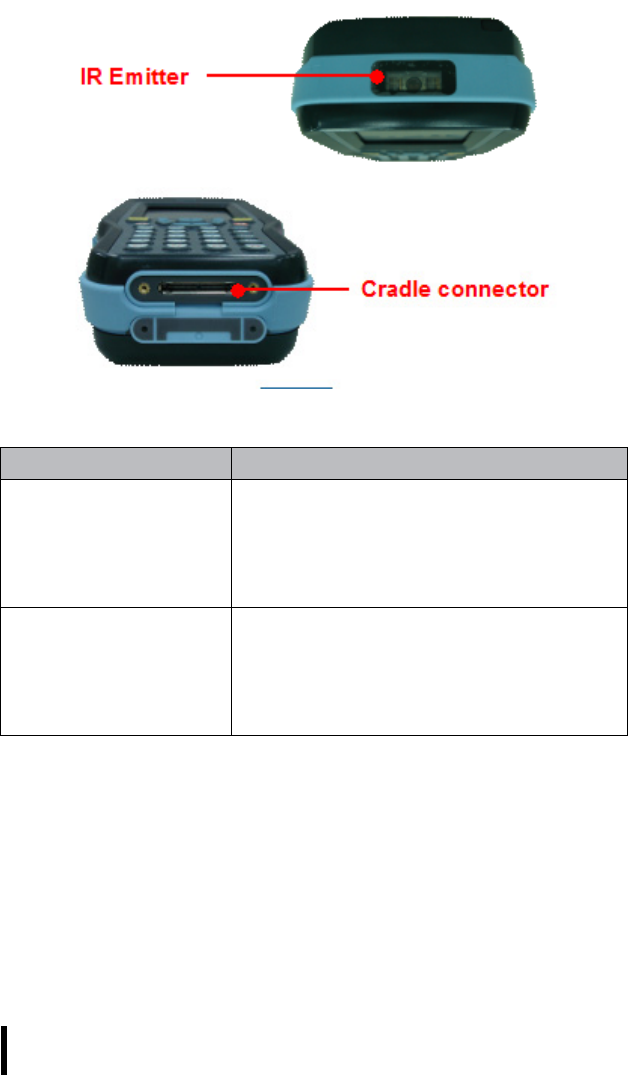
Chapter 1 — Introducing the HT1100
8
Top and Bottom View
Component Description
Infrared (IR) port and
Barcode scanner
window
• Uses infrared technology to transmit
and receive data from other IR-
enabled devices.
• Scans barcodes when pressing the left
and right barcode buttons
Cradle connector Connects the HT1100 to cradle, enabling
you to charge the battery, connect the
HT1100 to a computer to synchronize
data, connect to a LAN, and connect USB
devices.
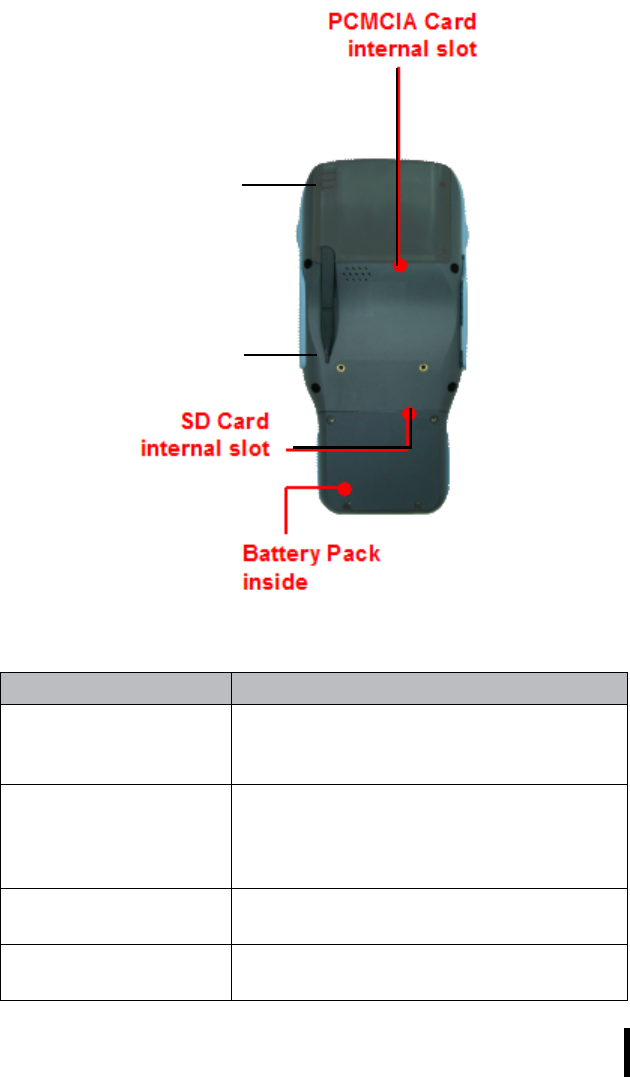
Chapter 1 — Introducing the HT1100
9
Back View
Component Description
PCMCIA slot (internal) Remove the cover to install a PCMCIA
card for added functionality. See Inserting
a PCMCIA Card on page 30.
Stylus Enables you to interact with the operating
system. Remove the stylus from the
holder and hold and use it the same way
you would a pen or pencil.
Speaker Enables you to hear audio from the
HT1100.
Reset button Press the end of the stylus into the button
to reset your device.
Stylus
Reset
button

Chapter 1 — Introducing the HT1100
10
Cradle
Memory card slot
(internal)
Accommodates Secure Digital memory
cards. See Inserting an SD Memory Card
on page 33.
Battery pack
compartment
Houses the removable and rechargeable
battery pack. See Installing the Battery on
page 12.
Status LED

Chapter 1 — Introducing the HT1100
11
Component Description
Cradle connector Insert the HT1100 to this connector to
charge the battery, synchronize data with
a PC, connect to the internet, connect
serial devices, or connect USB devices.
DC-in jack Connect the AC adapter to this jack to
supply power to the cradle and charge the
HT1100 battery.
USB mini type B port
(client)
Connect a USB mini type B connector to
this port.
RS232 port Connect a serial connector to this port for
serial communications.
RJ-45 connector Connect this jack to the LAN.
USB type A port (host) Connect a USB type A connector to this
port.
Status LED Indicates that power is connected.

12
Chapter 2
Getting Started
This chapter explains how to install and charge the battery, how to
check battery status, how to turn on the HT1100, and how to calibrate
the screen.
Installing the Battery
This section explains how to install the battery.
WARNING!There is a risk of fire and burns if the battery pack
is handled improperly. DO NOT disassemble, crush, puncture,
short external contacts, or dispose the battery pack in fire or
water. DO NOT attempt to open or service the battery pack.
Dispose of used batteries according to local recycling guide-
lines in your area.
A backup battery cell is embedded into your device to prevent data
loss in instances when the removable battery pack is removed or com-
pletely discharged. This backup battery cell will only support the sys-
tem for a maximum of 60 minutes.
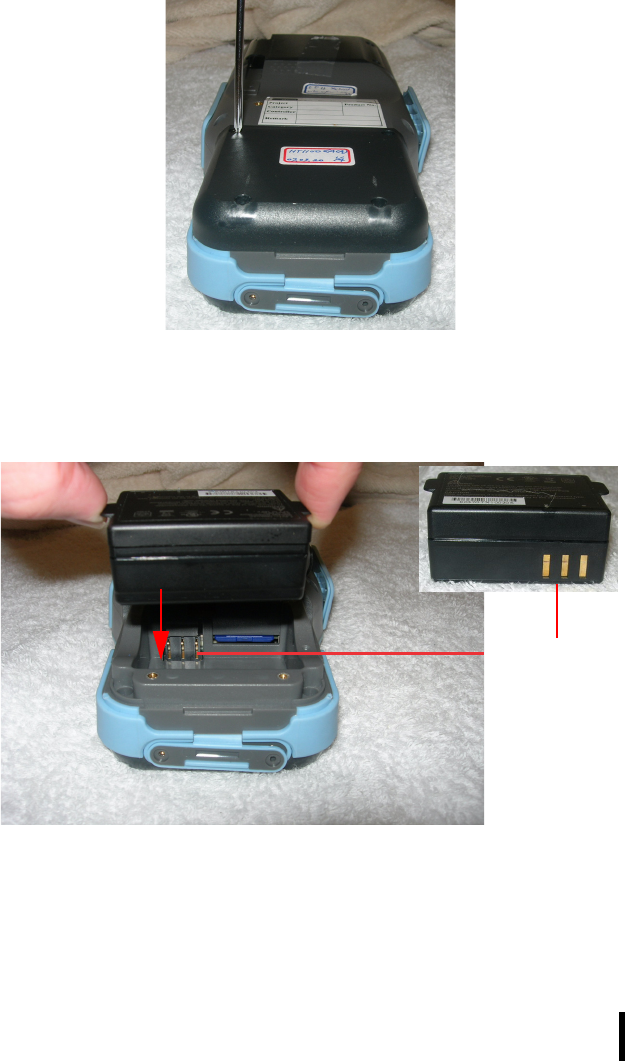
Chapter 2 — Getting Started
13
1. Remove the screws that secure the battery compartment
cover to the chassis.
2. Align the battery pack, making sure the battery contacts are
aligned with the contacts in the compartment and place the
battery in the compartment as shown in the following illustra-
tion.
3. Replace the battery compartment cover.
Contacts
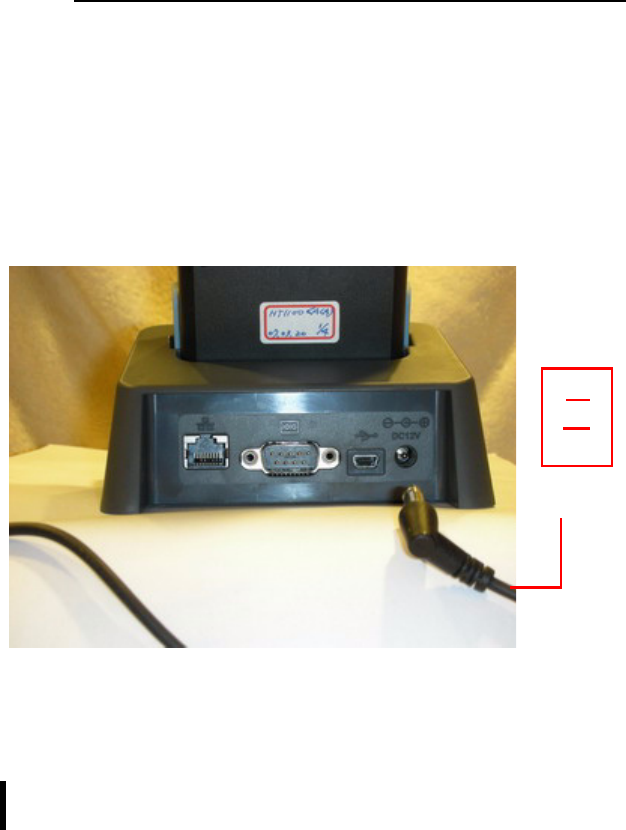
Chapter 2 — Getting Started
14
Charging the Battery
Before using the HT1100 for the first time, you need to charge it for
about 2 hours. After that, you can charge the HT1100 every day to
recharge the battery to full capacity. Charge the HT1100 using the
docking station.
CAUTION! Operating the HT1100 for the first time without
fully charging the backup battery may result in loss of data
stored in RAM memory. Allowing the battery to go below 3%
charge may result in loss of data.
NOTES:
•Data you enter may not be properly stored until the
built-in backup battery has been adequately charged.
•When the battery power is below 10%, the HT1100
will enter suspend mode.
Charging the Battery with the Docking Station
1. Plug the AC adapter cable into the power jack on the docking
station, then connect the AC adapter into an electrical outlet.
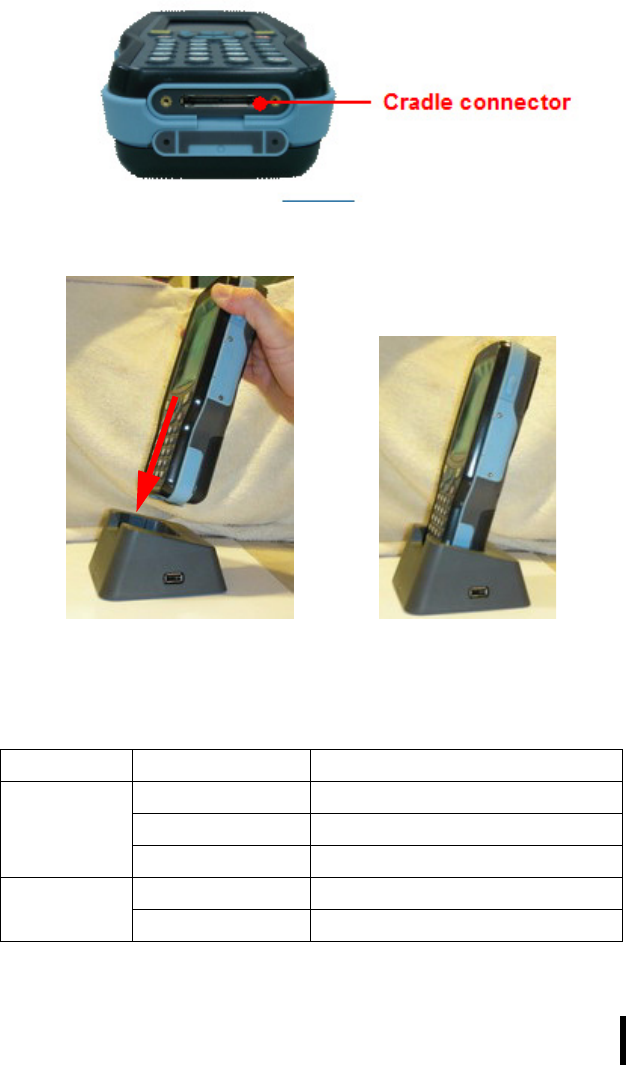
Chapter 2 — Getting Started
15
2. Flip open the docking connector cover on the bottom of the
HT1100.
3. Slide the device into the docking station until it clicks into
place.
4. The connection is secure when the bottom edge of the device
is aligned with the docking station, and the LED indicator on
the device lights up green.
LED Status
LED Meaning
HT1100 Blinking Red Charging
Solid Green Charging complete
Flashing Green Battery low (< 13% charge)
Docking
Station
Solid Green HT1100 is inserted.
Off HT1100 is not inserted
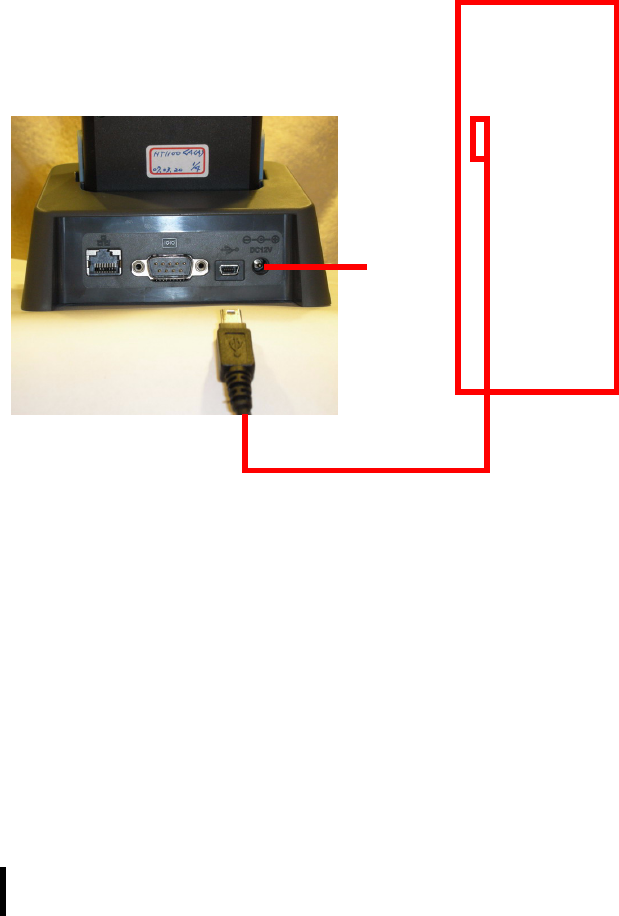
Chapter 2 — Getting Started
16
Connecting the HT1100 to a PC
Use the USB cable to connect the HT1100 to a PC to use with Active-
Sync. Refer to See Synchronizing with Your Computer on page 48.
1. Connect the USB mini type B connector to the mini port on the
cradle (A).
2. Plug the other end of the USB cable into the USB port on the
PC (B).
A
B
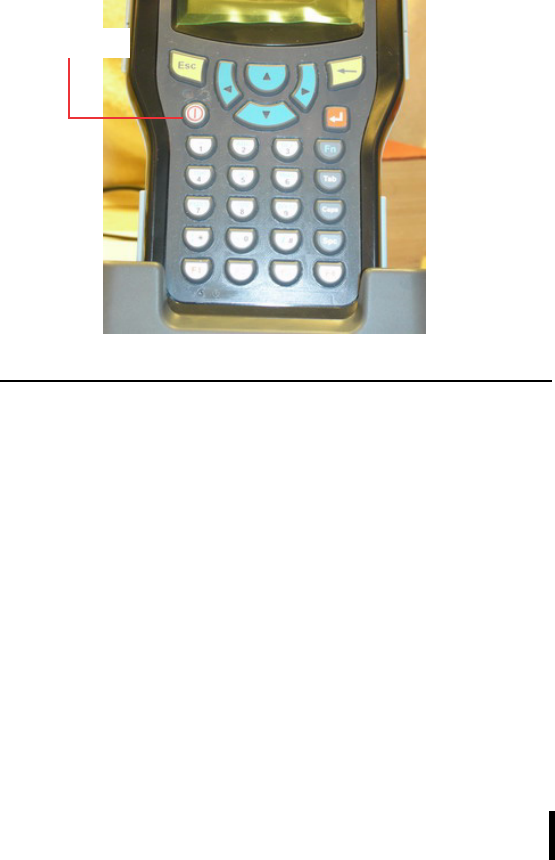
Chapter 2 — Getting Started
17
Turning the HT1100 on for the First Time
After you have initially charged your device for about 1.5 hours the
device is ready to be used. You can now start up your device where
you’ll calibrate the display, learn some basic stylus usage, and set up
the system time zone, date and time.
Powering On
1. Turn on your device by pressing the power button on the front
panel.
NOTE:The HT1100 screen ships with a protective plastic film.
You may remove this if desired by peeling from one corner.
The screen will be more susceptible to scratching without the
film, but will be more readable.
2. The HT1100 welcome screen appears for a moment followed
by the Windows CE screen.
Power Button
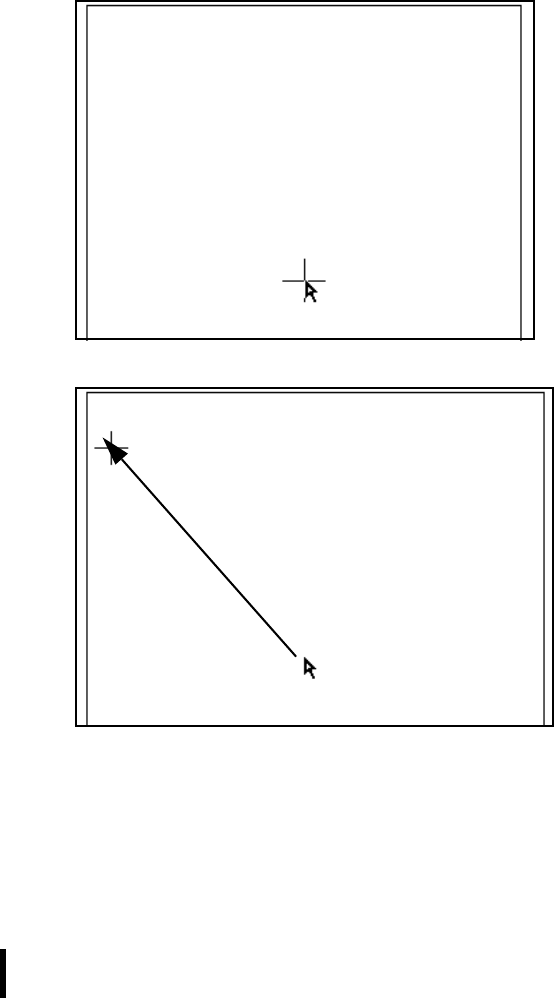
Chapter 2 — Getting Started
18
Calibrating the HT1100 Screen
The calibrate screen automatically appears when the unit is powered-
on for the first time or after the system is reset.
1. Tap the center cross hair firmly and accurately with the stylus.
The cross hair moves to the next location.
Carefully press and briefly hold stylus on the center of the target.
Repeat as the target moves around the screen.
Press the Esc key to cancel.
Carefully press and briefly hold stylus on the center of the target.
Repeat as the target moves around the screen.
Press the Esc key to cancel.
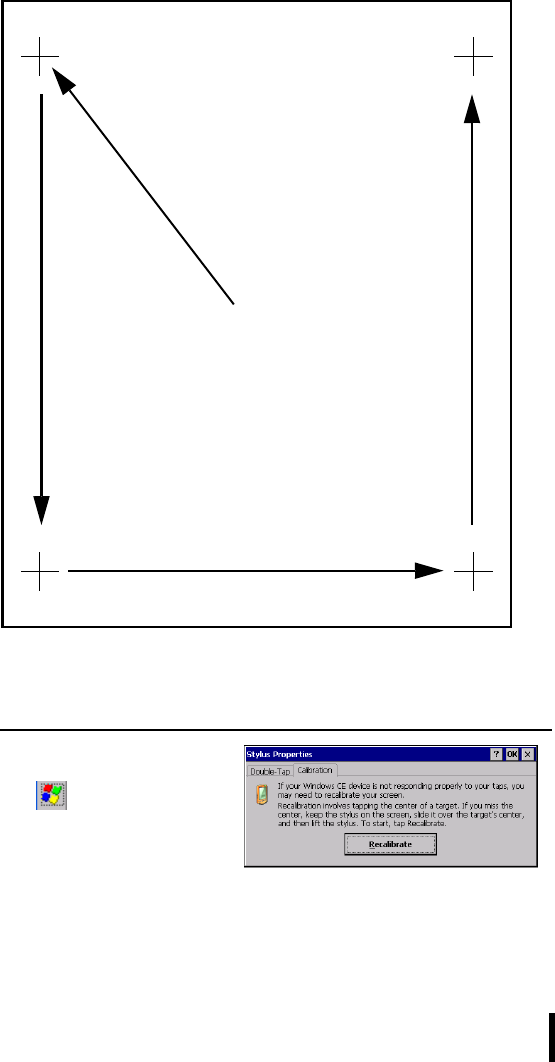
Chapter 2 — Getting Started
19
2. Continue tapping the cross hairs until the screen has been cal-
ibrated.
3. After calibration is finished, press the Enter key to save the
settings or press Esc to revert to the previous settings.
NOTE: To recalibrate
the screen at any time,
tap Start →
Settings→ Control
Panel. Then double-tap
Stylus. Tap the Calibra-
tion tab, and tap Recalibrate.
New calibration settings have been measured.
Press the Enter key to accept the new settings.
Press the Esc key to keep the old settings.
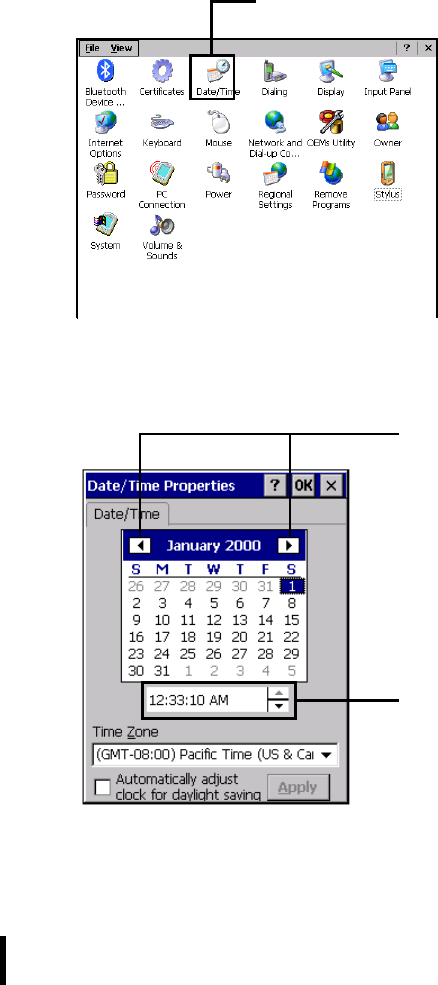
Chapter 2 — Getting Started
20
Setting the Time and Date
Follow these instructions to set the time and date.
1. Tap Start→ Settings→ Control Panel.
2. Double-tap Date/Time.
3. Tap the arrows next to the month to select the correct month.
4. Select a field in the time box and tap the arrows next to the
time to change the value of the field.
Date and time
Set month
Set time
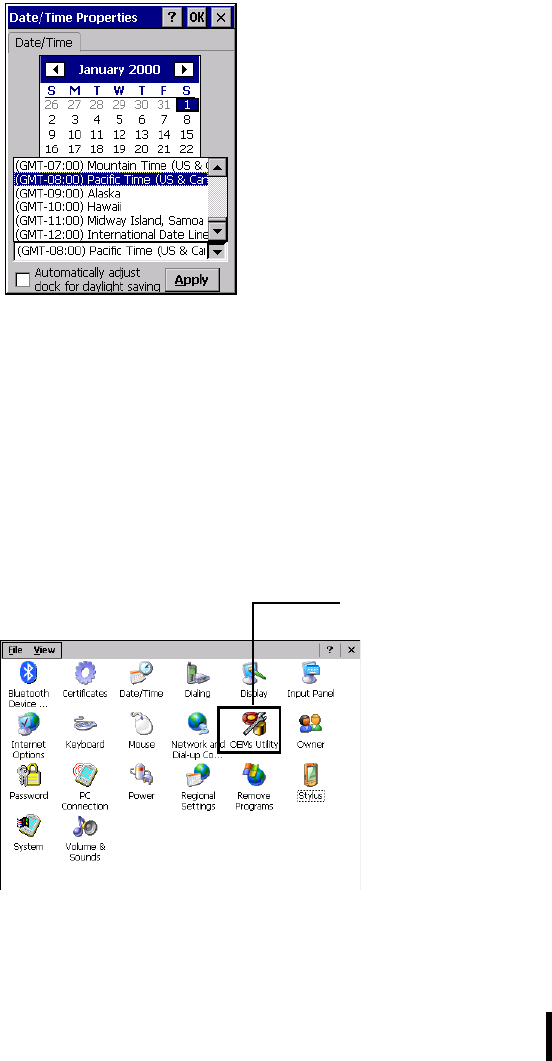
Chapter 2 — Getting Started
21
5. Tap the drop-down arrow next to Time Zone to select the cor-
rect time zone for your area.
6. Check the box next to Automatically adjust... to have the OS
automatically adjust for daylight saving time.
7. Click Apply to save the settings.
Adjusting the Screen Brightness
Follow these instructions to adjust the screen brightness.
1. Tap Start→ Settings→ Control Panel.
2. Double-tap OEMs Utility.
3. Click the Display Manager tab.
OEMs Utility
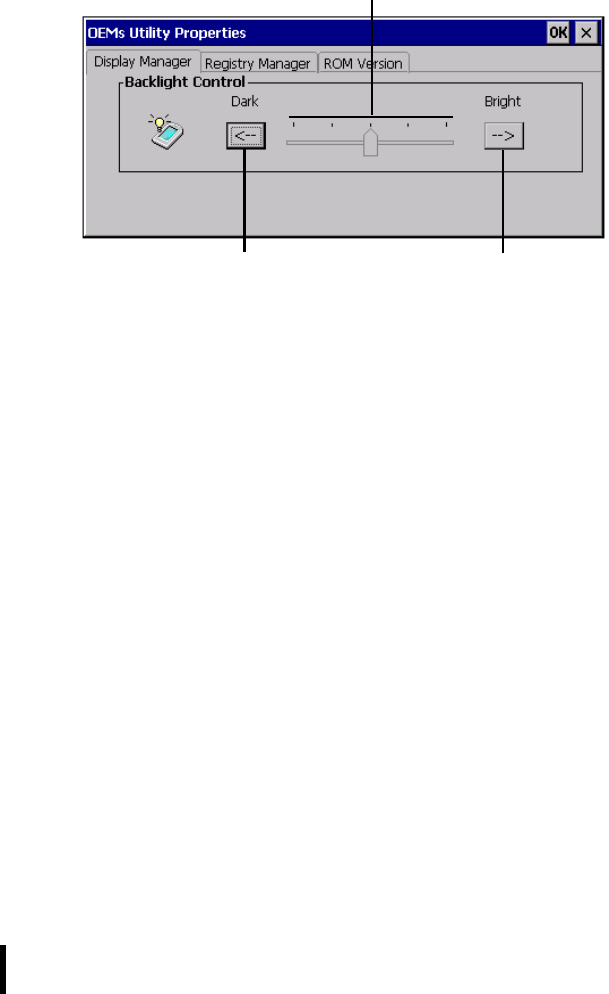
Chapter 2 — Getting Started
22
4. Under Backlight Control, click the Dark arrow to make the
screen darker, or click the Bright arrow to make the screen
brighter.
5. Click the close button to exit the utility.
Click to make the
backlight darker
Click to make the
backlight darker
Drag slider to make the back-
light brighter or darker
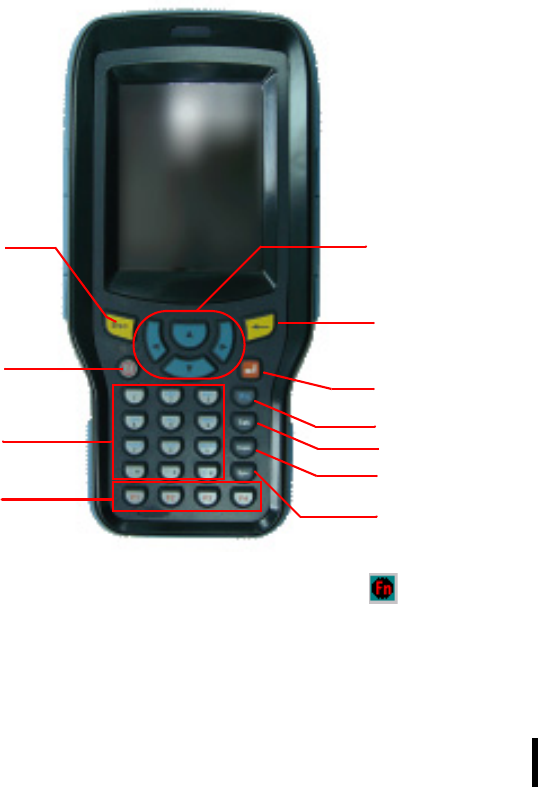
23
Chapter 3
Using the Hardware
Keypads and Function Buttons
The keypad enables you to both enter information and interact with the
HT1100 operating system, and also operate secondary functions using
the function keys and Fn key.
The following illustration shows the keypad keys.
When the blue function (Fn) key is pressed, an icon appears in the
system tray.
Navigation
keys
Backspace
Enter
Function
Tab
Caps
Space
Keypad
Function
keys
Escape
Power
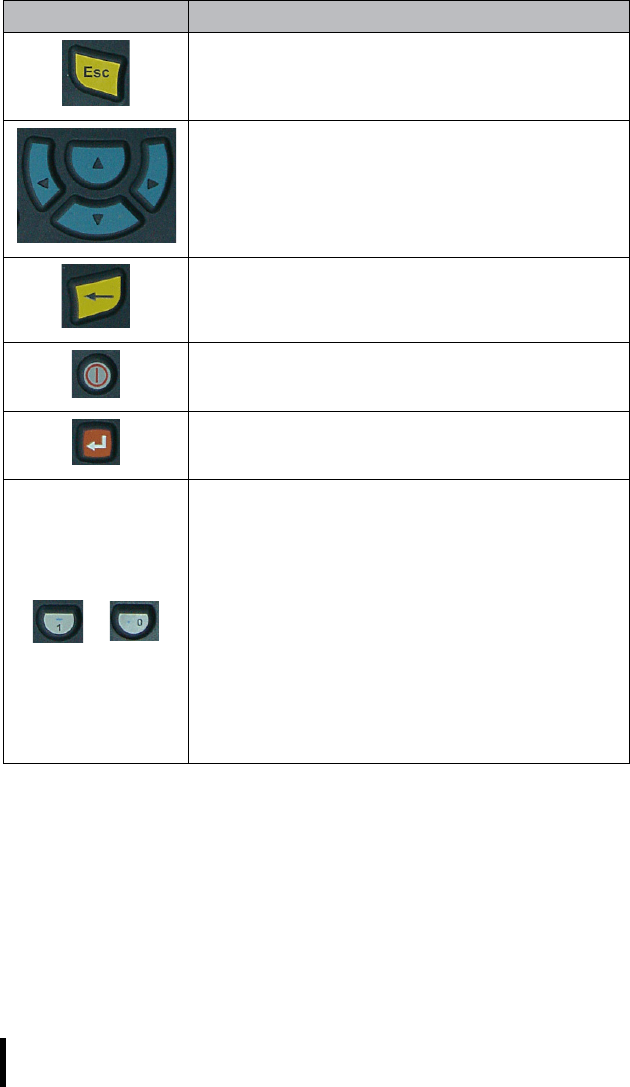
Chapter 3 — Using the Hardware
24
The following table describes the keypad keys.
Key Main Function
Escape key.
Navigation keys enable you to move up and
down in menus or dialog boxes.
Back space deletes a previous character.
Turns the HT1100 on and off.
Press the Enter key to confirm a command or
action.
~
Number 1
Alphanumeric 2, a, b, c
Alphanumeric 3, d, e, f
Alphanumeric 4, g, h, i
Alphanumeric 5, j, k,
Alphanumeric 6, m, n, o
Alphanumeric 7, p, q, r, s
Alphanumeric 8, t, u,
Alphanumeric 9, w, x, y, z
Number 0, space
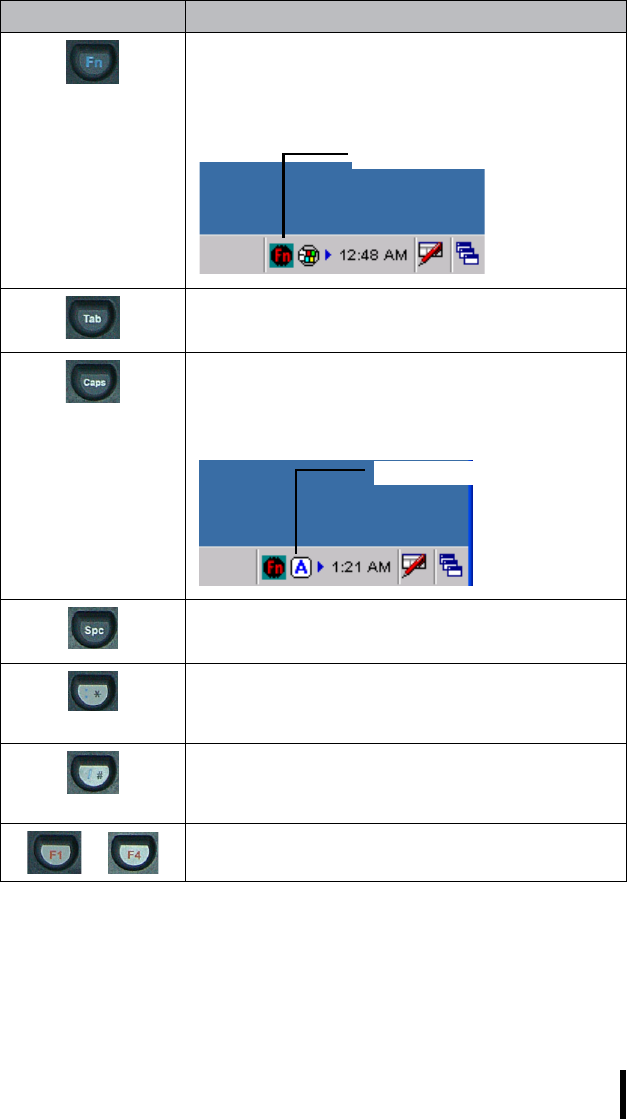
Chapter 3 — Using the Hardware
25
Press the Fn key to toggle between alphabetic
and numeric mode.
When the Fn icon is displayed in the system
tray, the HT1100 is in alphabetic mode.
Press to insert tab.
Press to make alphabetic characters
uppercase.
When CAPs is on, an icon appears in the
system tray.
Press to insert a space in text.
When in numeric entry mode, press this key to
enter an asterisk. When in alphabetic mode,
press this key to enter a colon.
When in numeric entry mode, press this key to
enter an pound sign. When in alphabetic mode,
press this key to enter a forward slash.
~ You can assign function keys 1 to 4 to run
applications.
Key Main Function
Function key icon
Caps icon